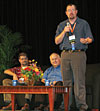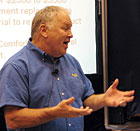
At the opening session, certified Home Energy Rating System (HERS) rater Bob Brice (standing) of Cenergy informs the crowd to do far more “than just sell boxes.” Fellow panel members (seated, from left to right) Steve Saunders, David Richardson, and Rob Falke listen.
Answer:There are many schools of thought on this topic - and that was most evident at HVAC Comfortech 2007, held in St. Louis recently.
Each of the five panelists brought up on stage at the conference’s opening session had a slightly different view, opinion, and answer for the issue/question noted above. The same could be said during the audience participation segment, when conference attendees fired off probing questions for the selected five to mull over.
In the end, each member of the panel informed what works for them and for their respective company. The theme for the interactive panel discussion was “Energy Crisis: The Comfort Equation,” but topics jumped all over the map, from HVAC system design and performance to whole-house performance. The same objective was in mind, though: how to profitably deliver real comfort and an efficient, clean environment to consumers.
PROMOTES PERFORMANCE-BASED CONTRACTING
Being president of National Comfort Institute (NCI), Cleveland, Ohio, panelist Bob Falke encouraged attendees to get into whole-house performance testing. Rather than just quoting new equipment, Falke noted that an NCI-certified contractor “will test your entire heating and air conditioning system with sophisticated test instruments, and offer the best solutions for your home comfort system.”As Falke pointed out, NCI widened its scope as it evolved to include a total system approach to design, installation, and service of systems. Falke called this holistic approach “performance-based contracting.”

Steve Saunders, president of Tempo Mechanical, provides a serious observation during the opening session at Comfortech.
This is done, he said, by measuring all system parameters, including static pressure, airflow, temperatures, humidity, refrigerant charge, carbon monoxide (CO), combustion efficiency, and more. The next task is to diagnose and fix the system’s deficiencies, “making it perform properly to deliver the best possible ‘total system performance,’” he said.
Falke stressed that contractors who follow this approach are different from the average service company because “they do more than simply fix or replace equipment. They also focus on maximizing the comfort, safety, and energy efficiency of the systems they sell and service.”
Attendees that came to NCI’s booth at the exhibit hall were able to get advice on training, marketing, sales, and performance testing. Featured at NCI’s booth were its CO/combustion training, as well as its 3000 low-level CO monitor.
NCI also featured its Comfort House, a display that provided Falke the opportunity to show contractors how they can begin to measure system performance, as he put it, “correctly.”

During the audience participation segment, Bob Brice (far right) answers a question from the crowd. Ready to jump in to provide a follow-up comment are fellow panel members David Richardson (far left) and Bob Falke (center).
FELLOW PANELISTS SPEAK OUT
To some extent, fellow panelist Bob Brice of Cenergy, Waukee, Iowa, echoed Falke’s sentiments, pushing contractors to do far more “than just sell boxes.” As a certified HERS (Home Energy Rating System) rater, Brice diagnoses energy-related problems and recommends solutions that are, in his estimation, cost-effective. He said Cenergy has a staff of trained HERS raters and also offers Manual J8 load calculation services in residential HVAC “to help contractors choose appropriate equipment for new and existing homes.”Brice took his message to the masses in a later, separate seminar, “Should You Bring Energy Rating Services into Your Business Mix?” He noted that system certification in customers’ homes is a mandate in California, which means this may eventually pass along to every state. He recommended that contractors work with an energy rater “or become one yourself.”
He thought such strategy would not only put a contracting business ahead of the regulatory curve, but also differentiate the company in the marketplace.
Representing the Air Conditioning Contractors of America (ACCA), panelist Wes Davis, among other suggestions and advice, encouraged attendees to join the association in order to be better than - and a step ahead of - the competition.
Contractors on the panel included David Richardson of Richardson Heating and Air Conditioning, Frankfort, Ky., and Steve Saunders, president of Tempo Mechanical, Dallas, Texas. Both encouraged the crowd to think outside the box and step into the world of whole-house assessing.
“We are a firm believer in performance-based contracting,” offered Saunders. “We are a supporter of National Comfort Institute and what they teach. They brought a whole lot of good to our commercial division.”
Thinking off the top of his head, he concluded, “There is a lot of opportunity for improving what I’ll call the never-ending, ongoing energy crisis. There is an opportunity for us to be at the center of a national issue, which requires national solutions to help America.”
Richardson agreed. In a later and different session, Richardson teamed up with Dominick Guarino of NCI to present “Performance-Based Selling for Fun and Profit.” Here Richardson showed how this approach “engages the customer on many different levels” and how both contractor and customer can discover, together, what systems work best for them.
“I totally believe in it,” said Richardson.

Bob Falke, president of National Comfort Institute, brings home a point during his presentation at the Comfort House.
TAKE QUESTIONS
After the five panelists made their individual sermons, they collectively fielded questions from the audience. The initial inquiry dealt with 13 SEER, whether they thought the choice and mandate was best for the industry? Saunders took the first stab, simply deadpanning, “Yes.”After the laughter subsided, Saunders quickly jumped back in, complimenting the manufacturers for meeting the deadline, noting that the final decision and mandate did not come until late in the equation. Richardson, however, was not so glowing.
“From an installation standpoint, it did make my life difficult,” confessed the Kentucky contractor, noting that the older equipment he has had to change out is usually smaller than the new, larger higher-efficiency models. “This caused some headaches.”
Still, he added, “Not that I’m knocking it. It’s a great thing to try to take energy [to a higher level] wherever we can.”
Davis was not so kind. “I think we tried to fix a problem with a box, instead of trying to fix the problem with the people in the dark,” he declared, which drew another round of applause.

Some of the industry’s top-notch consultants supplied, for free, answers to conference-goers’ questions in a 90-minute, rapid-fire town hall session.
ALSO AT THE EVENT
Comfortech had more offerings during the event. Not only were there many seminars to choose from - ranging from business management to sales and marketing; from technical to ventilation and IAQ; from business opportunity to you-name-it - there was also a slot of “presidential” seminars earmarked specifically for business owners. Sessions covered in this area included “Why Plan for Succession?”, “Ten Tips for Developing a Succession Plan,” and “Retirement: How to Make Succession Work.”The day prior to the conference’s kickoff at St. Louis’ America’s Center, Women in HVACR held its annual meeting at the same convention center, while the Radiant Panel Association offered its radiant basics workshop. During this same time period, Honeywell’s Residential HVAC businesses hosted its first national customer conference, “Forward Thinking.”
Other special programs offered included:
• a general session keynote address from Mark Swepston of Atlas Butler Heating & Cooling, Columbus, Ohio;
• the Comfort House, whereby attendees could travel room-to-room with air diagnostic professionals;
• some of the industry’s better-known consultants provided an opportunity for free consultation at a 90-minute, rapid-fire town hall session;
• industry exhibitors, from 1-800-Air-Repair LLC to Zone first, with several taking the opportunity to make new product announcements.
Publication Date:11/12/2007

Report Abusive Comment